Do I really need to acclimate my new wood flooring material before I nail it down?
Answer: Yes, but…
Acclimate is the wrong word. It implies a change to adjust to a new condition. When wood flooring is moved from a hot kiln to a breezy warehouse then to a jobsite it acclimates, it adjusts to the new conditions every time it experiences new conditions. But that’s what happens, not what needs to be done. And that’s why wood flooring frequently goes wrong – things don’t get done, and then bad things happen.
A better word might be “training” or “preparation.” Words that imply some anticipation of future conditions. That’s what wood flooring acclimation is all about, preparation for future conditions, not current conditions. The wood needs to be trained or prepared for the future.
Wood floors are great, especially the old, foot-worn type that have gaps and cracks:
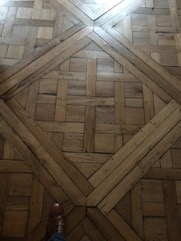
But they can also be total disasters, looking more like ill-fitting pants:
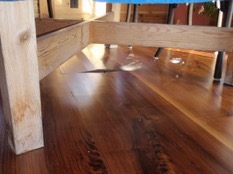
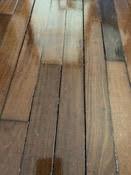
The problem is the wood. It misbehaves. But it has a co-conspirator – water. As they come together and separate the wood moves, and there’s no stopping it.
Wood is porous. REALLY porous. On top of that, the interior surface of all those pores is hydrophilic – it’s a REALLY attractive place for water. As far as water vapor is concerned, one square foot of wood floor area looks like 5,000 square feet of attractive surface.[1] And, that water can pile on in layers, so, that porous, interior surface can act more like 25,000 square feet of attractive surface.
When the water vapor and the wood get together the wood changes size. This may seem odd, but for many liquids and solids, this is not odd. Mixtures aren’t the same as pure materials and one difference is how densely they pack themselves. Sometimes less dense, sometimes more dense. Of course, for wood, we’re all familiar with what happens, so, I’ll skip all that explaining: high relative humidity = wood expansion, low relative humidity = wood shrinkage. That’s a big topic with lots of implications, and lots of entropy stuff, but not for today.
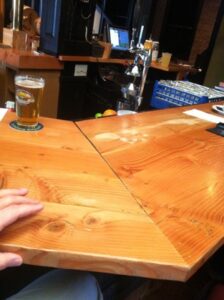
These days, the National Wood Flooring Association (NWFA) has a great installation manual that everyone should read at least twice before every wood flooring installation. It wasn’t always that way, it wasn’t even that way last year. With hope, you read the entire thing, but if you stop after just the first few paragraphs in the first chapter (not even the chapter titled Acclimation) that may be enough. It’s some of the most pointed and unfollowed installation advice in our entire industry:
“Wood flooring should be one of the last jobs completed on the construction project.”
“Unless a waiver or letter of protest listing exceptions exists, installation constitutes acceptance of subfloor/substrate, the jobsite itself – including the ambient temperature and relative humidity at the time of installation, and all impacting variables that may affect a wood floor.”
Ha!
Usually, wood flooring is installed after drywall/plaster and before fixture installation (plumbing fixtures, appliances, etc.) – way before “one of the last” things. If it’s new construction, not renovation, there’s usually lots of other work going on simultaneously – with some of it “wet,” like ceramic tile. Maybe all the windows and doors are in, maybe not. In short, it’s the typical shit show.
Sometimes the installers will bitch about this or that jobsite condition and may even hold up installation for one reason or another, but a “waiver or letter of protest” would be like seeing a Grizzly bear in the woods – not unheard of, but an unusual, scary laxative.
With regard to acclimation, a clarification, provided by the NWFA, of that second requirement listed above pretty much says it all:
“Do not deliver wood flooring to the jobsite or install wood flooring until appropriate temperature and humidity conditions have been achieved. Appropriate temperature and humidity conditions are defined as those conditions to be experienced in the building after occupancy.”
Now we’re talking: “…those conditions to be experienced in the building after occupancy.” That’s what it’s all about, future conditions, not current conditions.
When I got into the industry, back in the day, acclimation meant that you delivered the flooring material a week before the desired installation date and let it sit there.
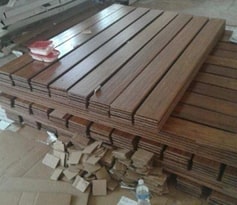
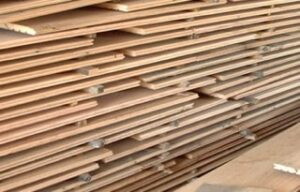
If you were lucky, it was stickered like the photo on the right. Usually, it was just left in a tight pile. After one week, you installed the floor. Done. Life was simple.
Unfortunately, that is acclimation and sometimes there were problems after installation. The thing is, the wood does acclimate to the current room conditions, that’s what it always does – if it was the middle of the Summer, it acclimated to hot and humid; if it was the middle of the Winter, it acclimated to cold and dry. But, that’s not proper acclimation and when the seasons changed the wood expanded or contracted and the clients complained about gaps or buckles.
The proper thing is to control the interior conditions – temperature and relative humidity – so that they are at the average of what the installed floor will experience during its service life. Then, acclimate the floor to those conditions, not just the current conditions. That’s exactly what the NWFA guidelines suggest.

Of course, if I could predict the future, I’d be quarantining in Lana’i or Molaka’i right now, not in a hotspot of a global pandemic. Likewise, if I could predict the future climate conditions of every wood floor installation, they would all have better outcomes. It’s hard to predict the future, and that makes this acclimation thing difficult.
For city, high-rise apartment projects this is a little easier. Usually there is no door to the exterior, usually the windows are mostly shut, and usually all workers enter the space from a climate-controlled hallway, and usually the mechanical systems are fully operational. It’s easier to control the interior conditions in high-rise apartments under construction than most other new construction scenarios and it’s easier to guess what the future conditions will be.
Single family homes are more troublesome and I’m not sure I’ve ever seen anyone do it perfectly. First, usually there’s still a window or a door that hasn’t been installed, or even delivered, yet. Second, the mechanical system is rarely fully operational. Third, workers are going in and out of the exterior doors constantly. And, the fireplace dampers are probably open. It’s difficult in single family homes to control interior conditions AT ALL while under construction, forget about getting them to some unknown future condition. I’ve seen temporary systems and temporary dehumidifiers and temporary humidifiers, but none are perfect. And that’s ignoring the massive amount of water that’s off-gassing from the newly placed concrete foundation and basement slab.

What to specify? What to do?
If the project is in a high-rise apartment, just go with the NWFA installation guidelines. No worries.
If the project is in a single-family home, first, know that it’s almost impossible to abide by those awesome guidelines. Second, do your best to anticipate the future interior conditions. Good luck with that, do your best. It depends where you are in the world, what sort of mechanical systems will be operating and how the occupants use the space. A commercial party space in a tropical, ocean front building will be very different than a living room in a ski chalet. Then, let the floor acclimate to the current conditions – not what the NWFA guidelines say, but just like it was done by all those knuckle draggers in the past. After it’s acclimated, install it either tight or spaced according to how you expect the wood to move in the future. If the future expectation is lower relative humidity then install it tight, without much spacing between boards – maybe only spacing around the perimeter of the room. If the future expectation is higher relative humidity, then install it with some regular spacing – maybe 1/16” per 32” – to allow for that future movement. This is not a perfect method, but it will allow the job to progress and often it’s the best that can be done.
Either way, make sure everyone understands that it’s wood and construction is not done in an operating room. The wood is going to expand and contract. Joints are going to open up between the boards. And, eventually, it will have that beautiful, foot-worn appearance. If that’s unacceptable, then specify linoleum or stone.
That’s about it for wood flooring and acclimation.
[1] That’s a conservative estimate. Surface area in porous materials is difficult to measure, but it may be more like 500,000 square feet of pore surface per square foot of floor area.
